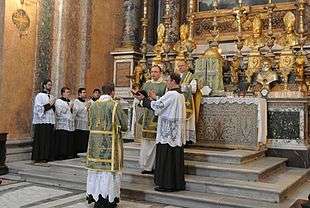Ite, missa est
Ite, missa est are the concluding Latin words addressed to the people in the Mass of the Roman Rite, as well as the Lutheran Divine Service. Until the reforms of 1962, at Masses without the Gloria, Benedicamus Domino was said instead. The response of the people (or, in the Tridentine Mass, of the servers at Low Mass, the choir at Solemn Mass) is Deo gratias ("thanks be to God").
Part of a series on |
| Roman Rite mass of the Catholic Church |
|---|
 |
| A. Introductory rites |
|
| B. Liturgy of the Word |
|
| C. Liturgy of the Eucharist |
|
| D. Concluding rites |
| "Ite, missa est!" |
|
|

Meaning
In the 19th century, it was common to explain the phrase elliptically, with missa the feminine participle of mittere, as in Ite, missa est [congregatio] "Go, it [viz., the assembly] is dismissed".[1] However, according to Fortescue (1910), the word missa as used in this phrase is not the feminine participle (Classical Latin missa), but rather a Late Latin form of what would be missio in classical Latin, meaning "dismissal", for a translation of "Go, the dismissal is made".[2]
Chupungco (1999) noted that "some persons have attempted" to "sublimate" the straightforward meaning of the phrase into an interpretation of missio "dismissal" as "mission" (as in, "go and be a missionary"), but judges this interpretation as "without foundation".[3]
The connection between the meaning "dismissal" and the 'deeper' meaning of "mission" was also discussed by Benedict XVI (without making an etymological claim) in Sacramentum caritatis (2007): "In antiquity, missa simply meant 'dismissal'. In Christian usage, however, it gradually took on a deeper meaning. The word 'dismissal' has come to imply a 'mission'. These few words succinctly express the missionary nature of the Church".[4]
Historically, there have been other explanations of the noun missa, i. e. as not derived from the formula ite, missa est. Medieval authors took the phrase to contain the noun missa "mass". Thus Guillaume Durand (13th century) suggests that the meaning is either elliptic missa est [finita] "the mass is finished", or that est should be taken absolutely, as meaning "the mass exists, is now accomplished fact".[5] But, in fact, the ecclesiastical Latin noun missa "mass" is itself derived from the missa in this liturgical formula.
Also Du Cange (1678) reports "various opinions on the origin" of the noun missa "mass".[6] Fortescue (1910) cites more "fanciful" etymological explanations, notably a latinization of Hebrew matsâh (מַצָּה) "unleavened bread; oblation", a derivation favoured in the 16th century by Reuchlin and Luther.[7]
History and liturgical use
It is one of the oldest formulae of the Roman Rite, recorded in Ordo I (6th or 7th century).[8] but if the noun missa "mass" is to be taken as a derivation from this formula, it must predate the 6th century and may date to as early as the 3rd, missa being a re-adoption into written Latin of the spoken Late Latin for missio.[9]
After the twelfth century, accretions began to be added to the Mass after the "Ite, missa est", changing it from a dismissal to a mere formula without relation to actuality. But only in the sixteenth century, with the establishment of the Tridentine Mass (Missal of Pope Pius V), were these accretions officially accepted as part of the Mass.
In this revision of the Roman Missal, the "Ite, missa est" was followed by a silent private prayer by the priest, then by the blessing and finally by the reading of what was called the Last Gospel (usually John 1:1-14, but since, until the reform of Pope Pius X, saints' feasts came to supplant most Sunday Masses, the Last Gospel on such Sundays was that of the Sunday Mass).
With the reform of Pope Paul VI "Ite, missa est" returned to its function as a dismissal formula. It is omitted if another function follows immediately and the people are therefore not dismissed.
"Ite missa est", not being variable like the Scripture readings and the collect, is part of the Order of Mass and has always been printed in that part of the Roman Missal. Being sung by an individual (ideally the deacon), not by a choir, it cannot be part of a polyphonic musical setting of the Mass. Only the "Deo gratias" response could be set polyphonically but again, because of its brevity, it rarely was, except in some early settings such as Machaut's Messe de Nostre Dame.
Other dismissal formulas
In 2008 alternative dismissal formulas were approved for Mass of the Roman Rite:[10]
- "Ite ad Evangelium Domini nuntiandum" (Go and announce the Gospel of the Lord)
- "Ite in pace, glorificando vita vestra Dominum" (Go in peace, glorifying the Lord by your life)
- "Ite in pace" (Go in peace)
In each case the response is "Deo gratias" (Thanks be to God).
The dismissal formulas in other liturgical rites are:
- Ambrosian Rite: "Procedamus in pace" (Let us go forth in peace). Response: "In nomine Christi" (In the name of Christ).
- Mozarabic Rite: "Solemnia completa sunt in nomine D. N. I. C: votum nostrum sit acceptum cum pace" (The celebration is completed in the name of Our Lord Jesus Christ; may our prayer be accepted with peace). Response: "Deo gratias" (Thanks be to God).
- Apostolic Constitutions: "Go in peace."
- Antiochene, Alexandrian and Byzantine liturgies: "Let us go forth in peace" (said by the deacon). Response: "In the name of the Lord." Then the priest says a short "prayer of dismissal".
- Latvian tradition: "Dieva žēlastība lai jūs pavada" (May the grace of God accompany you)[11]
- Polish tradition: "Idźcie w pokoju Chrystusa" (Go in the peace of Christ)[12]
See also
References
- so Friedrich Diez, Etymologisches Wörterbuch der roman. Sprachen (1887), p. 212, cited by Fortescue (1910).
- "It is a substantive of a late form for missio. There are many parallels in medieval Latin, collecta, ingressa, confessa, accessa, ascensa — all for forms in -io. It does not mean an offering (mittere, in the sense of handing over to God), but the dismissal of the people, as in the versicle: 'Ite missa est' (Go, the dismissal is made)." Fortescue, A. (1910). Liturgy of the Mass. In The Catholic Encyclopedia. New York: Robert Appleton Company.
- Anscar J. Chupungco, Handbook for Liturgical Studies: The Eucharist, Volume 3 of Handbook for Liturgical Studies, Liturgical Press, 1999, p. 3.
- (Pope Benedict XVI, Sacramentum caritatis, 51)
- "Durandus (Rationale, IV, 57) suggests several interpretations. It has been thought that a word is omitted: Ite, missa est finita; or est is taken absolutely, as meaning 'exists, is now an accomplished fact'". Fortescue (1910).
- De vocabuli origine variæ sunt Scriptorum sententiæ. Hanc enim quidam, ut idem Baronius, ab Hebræo Missah, id est, oblatio, arcessunt : alii a mittendo, quod nos mittat ad Deum, ut est apud Alcuinum de Divinis offic. Honorium Augustod. lib. 1. cap. 2. Rupertum lib. 2. cap. 23. etc. Du Cange, et al., Glossarium mediae et infimae latinitatis, éd. augm., Niort : L. Favre, 1883‑1887, t. 5, col. 412b, s.v. 4. missa.
- "The origin and first meaning of the word, once much discussed, is not really doubtful. We may dismiss at once such fanciful explanations as that missa is the Hebrew missah ("oblation" — so Reuchlin and Luther), or the Greek myesis ("initiation"), or the German Mess ("assembly", "market"). Nor is it the participle feminine of mittere, with a noun understood ("oblatio missa ad Deum", "congregatio missa", i. e., dimissa — so Diez, "Etymol. Wörterbuch der roman. Sprachen", 212, and others).
- "When the prayer [Post-Communion] is over, that one of the deacons appointed by the archdeacon looks towards the pontiff to receive a sign from him and then says to the people: Ite missa est. They answer: Deo gratias" (Ordo I, ed. Atchley, London, 1905, p. 144).
- "It is our formula of the old dismissal (apolysis) still contained in all liturgies. It is undoubtedly one of the most ancient Roman formulæ, as may be seen from its archaic and difficult form. All the three oldest Roman Ordines contain it." Fortescue (1910).
- ZENIT Staff (14 October 2008). "Mass Could End With More Than "Go in Peace"". ZENIT. Retrieved 16 November 2019.
- "Vatikāns apstiprinājis Svētās Mises noslēguma formulas" [The Vatican has approved closing formulas of Holy Mass]. Katolis.lv (in Latvian). Retrieved 16 November 2019.
- "Watykan: Nowe formuły rozesłania kończące Mszę św" [Vatican: New sending formulas ending Mass]. Liturgia.pl (in Polish). 22 October 2008. Retrieved 16 November 2019.
External links
| Look up ite missa est in Wiktionary, the free dictionary. |
- Fortescue, A. (1910), Ite Missa Est, The Catholic Encyclopedia, New York: Robert Appleton Company.
- See Ite Missa Est in the 1962 Missale Romanum with MP3 Audio